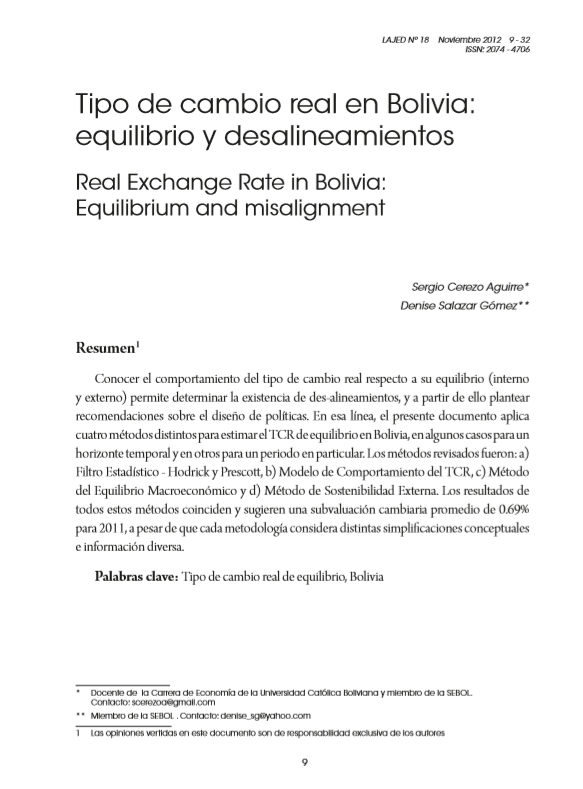Real Exchange Rate in Bolivia: Equilibrium and misalignment
DOI:
https://doi.org/10.35319/lajed.201218129Keywords:
Equilibrium real exchange rates, BoliviaAbstract
The behavior of the real exchange rate with respect to its equilibrium (internal and external) follow determines the existence of desalignment, and from these developing recommendations for policy design. In this case, this paper makes a methodological review of four different methods to estimate the equilibrium real exchange rate and applies then to Bolivia, in some cases, for a time horizon and others for a particular period. The methods reviewed were: a) Hodrick y Prescott filter, b) Estimation of a Behavioral Equilibrium Exchange Rate, c) Macroeconomic Balance Approach and d) External Sustainability Approach. The results of the methods agree and suggest an undervalued exchange rate (average) of 0.69% for 2011, even though each methodology considers different conceptual simplifications and information.
Downloads
References
Ades, Alberto; Masih, Rumi y Tenengauzer, Daniel. (1999). “GSDEEMER”. Third Edition.
Aguilar, M.A. (2003). Estimación del tipo de cambio real de equilibrio para Bolivia. Revista de Análisis del BCB, 6 (1)
Arellano, S. y Larraín, F. (1996). Tipo de cambio real y gasto público: un modelo econométrico para Chile. Cuadernos de Economía 33(9), 47-75.
Aukrust, D. (1977). Inflation in the open economy: A Norwegian model. Washington D.C.: Brookings:
Balassa, B. (1964). The purchasing power parity doctrine: A reappraisal. Journal of Political Economy 72, 584-596.
Baxter, Marianne y Crucini, Mario J. (1992). Business cycles and the asset structure of foreign trade. Institute for Empirical Macroeconomics 59, Federal Reserve Bank of Minneapolis. Discussion Paper.
Bello, O.; Heresi, R. y Pineda, R. (2010) El tipo de cambio real de equilibrio: un estudio para 17 países de América Latina. Macroeconomía del desarrollo, CEPAL, Serie 82.
Caputo, R. y Núñez, M. (2008). Tipo de cambio real de equilibrio en Chile: enfoques alternativos. Economía Chilena 11 (22), agosto.
Cerezo S.; Humerez, J. y Cossio. J. (2010). El desempeño del régimen cambiario boliviano en el periodo post-estabilización. Documento de trabajo, BCB.
Cerezo S. y Salazar, D. (2011). Tipo de cambio real de equilibrio en Bolivia: cinco enfoques alternativos. Documento de trabajo presentado en el 4EEB-BCB en la ciudad de Sucre.
Cerda, R.; Donoso, A. y Lema, A. (2005). Análisis del tipo de cambio real: Chile 1986- 1999. Cuadernos de Economía, 42 (126), 329-56, noviembre.
Cerruti, E. y Mansilla, M. (2008). Bolivia and Its Booming Gas Sector: Should We Worry About a New Case of Dutch Disease? IMF Working Paper, No. 08/154, junio.
Choudhri, Ehsan y Khan, Mohsin (2004). Real Exchange Rates in Developing Countries: Are Balassa-Samuelson Effects Present? IMF Working Paper 04/188. International Monetary Fund.
Debelle, G. y Faruqee, H. (1996). What Determines the Current Account? A CrossSectional and Panel Approach. IMF Working Paper 96/58.
Ferreyra, J. y Herrada, R. (2003). Tipo de cambio real y sus fundamentos: estimación de la desalineación. Revista Estudios Económicos Nº 10. Banco Central de Reserva del Perú.
Fondo Monetario Internacional, FMI (2008). Por una economía mundial. Informe anual.
Fondo Monetario Internacional, FMI (2011): Bolivia 2011 Article IV Consultation Cover, pag 21.
Frenkel, J. y Razin, A. (1986). Real exchange rates, interest rates and fiscal policies. Economic Studies Quarterly, 37, 99-113.
Frenkel, J. y Razin, A. (1987). Fiscal Policies and the World Economy, Cambridge, Mass.: MIT press.
Hodrick, Robert J. y Prescott, E.C. (1980). Postwar U.S. Business Cycles: an Empirical Investigation. mss. Pittsburgh: Carnegie-Mellon University; Discussion Papers 451, Northwestern University
Hoffmann, Mathias y MacDonald, Ronald (2003). A Re-examination of the Link Between Real Exchange Rate and Real Interest Rate. CESIFO, Working Paper Nº. 894.
Isard, P. (2007). Equilibrium Exchange Rates: Assessment Methodologies. IMF Working Paper N°07/296.
Lee, J.; Milesi-Ferretti, G. M.; Ostry, J.; Prati, A. y Ricci, L. A. (2006). Methodology for CGER Exchange Rate Assessments. Fondo Monetario Internacional.
Lee, J.; Milesi-Ferretti, G. M.; Ostry, J.; Prati, A. y Ricci, L. A. (2008). Exchange Rate Assessments: CGER Methodologies. IMFOccasional Paper, Nº 261, Fondo Monetario Internacional.
Lee, J.; Milesi-Ferretti, G. A. y Ricci, L. A. (2008). Real Exchanges and Fundamentals: A Cross-Country Perspective. IMF Working Paper, WP/08/13, Fondo Monetario Internacional.
Lora, O. y Orellana, W. (2000). Tipo de cambio real de equilibrio: un análisis del caso boliviano en los últimos años. Revista de Análisis del BCB, 3 (1).
MacDonald, Ronald y Ricci, Luca (2003). Estimation of the Equilibrium Exchange Rate for South Africa. IMF Working Paper 03/44. International Monetary Fund.
Mendieta, P. (2007). El equilibrio de la competitividad cambiaria boliviana: un enfoque empírico. Documento presentado en la Reunión del Proyecto Conjunto sobre Variables no Observables, llevado a cabo en Buenos Aires el 15 de junio de 2007
Miyajima, Ken (2005). Real Exchange Rates in Growing Economies: How Strong Is the Role of the Nontradables Sector? IMF Working Paper 05/233. International Monetary Fund.
Obstfeld, M. (1981). Macroeconomic Policy, Exchange-Rate Dynamics, and Optimal Asset Accumulation. Journal of Political Economy, University of Chicago Press, 89(6), 1142-61, December.
Svensson, L. y Razin, A. (1983). The Terms of Trade and the Current Account: The Harberger-Laursen-Metzler Effect. Journal of Political Economy, 91, 97-125.
Williamson, John (1983). The Exchange Rate System. Policy Analyses in International Economics 5. Washington: Institute for International Economics.






